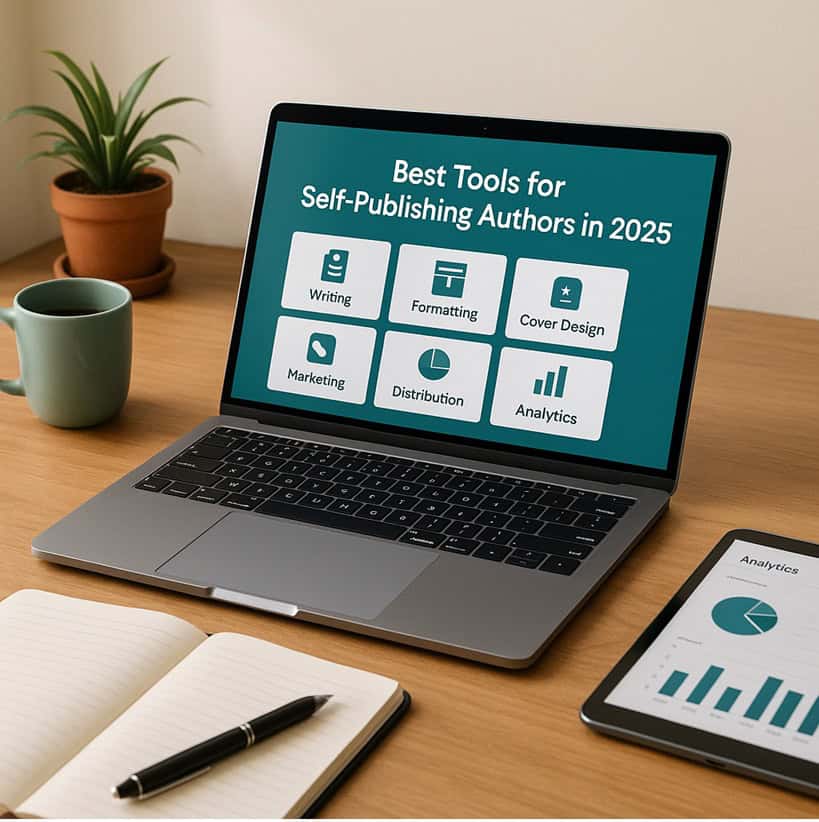Today’s Best Tools for Self-Publishing Authors
“Don’t be afraid of technology—it’s the modern writer’s superpower.” — Joanna Penn, The Creative Penn
Discover the essential tools for self-publishing every new indie author needs in 2025. From writing and formatting to cover design, marketing, and beyond, the best tools help you save time, stay organized, and publish like a pro.
If you’ve been writing for a while, you understand the power of tools in shaping your workflow. The right ones not only simplify your writing process and refine your manuscript but also empower you to market your book effectively, all within your budget.
Amid the multitude of apps and software platforms that emerge each year, it can be overwhelming to discern which tools for self-publishing authors are genuinely beneficial. This writer’s guide provides the direction you need to invest your time and money wisely.
This part of our series on self-publishing basics highlights the best tools for self-publishing across each stage of the process. It also encourages you to focus on what truly matters: creating great books that readers will love.
Step 1: Write Smarter and Faster
Recommended Tools
- Scrivener – A favorite among authors for complex projects. It lets you organize scenes, research, and notes in one place.
- Atticus – Combines writing and formatting for eBook and print in a single dashboard. Cloud-based, so you can work from anywhere.
- Google Docs – Still unbeatable for real-time collaboration and version control, especially if you work with an editor or co-author.
- Grammarly – Perfect for catching grammar and clarity issues in your drafts.
Pro Tip: Use a combination. Write in Scrivener or Atticus, polish in Grammarly, and collaborate in Google Docs. This approach can help you streamline your writing process, improve the quality of your drafts, and facilitate collaboration with editors or co-authors.
Step 2: Edit Like a Pro (Even on a Budget)
Editing is essential, but hiring a professional for every stage can be costly. Here’s how to combine tools for powerful results:
- ProWritingAid – Goes deeper than Grammarly with detailed reports on readability, pacing, and sentence variety.
- Hemingway Editor – Great for tightening prose. It highlights long or complex sentences and overused adverbs.
- Sudowrite – An AI writing assistant that helps rephrase sentences or expand ideas while maintaining your voice.
Pro Tip: Use these tools before sending your book to a professional editor. You’ll reduce editing costs and improve your manuscript’s quality.
Step 3: Format Your Book for eBook and Print
Formatting used to be one of the biggest pain points for self-publishers. In 2025, intuitive tools have changed the game.
- Reedsy Book Editor (Free) – Clean, easy interface for exporting EPUB and print-ready PDFs.
- Atticus – Adds visual customization, scene breaks, and chapter themes—perfect for authors who want creative control.
- Vellum (Mac only) – Known for its elegant, professional templates. Ideal for fiction and non-fiction alike.
Pro Tip: Always preview your layout on multiple devices (Kindle, tablet, phone) and print proofs before publishing.
Step 4: Design Covers That Sell
Your book cover is your first impression, and it’s your top marketing tool. Thankfully, you don’t need to be a designer to create a professional cover.
- Canva Pro – Offers customizable book cover templates and AI background removers.
- Book Brush – Designed specifically for authors, with spine calculators and full-wrap templates for paperbacks.
- Adobe Express – Simplifies professional-grade design with drag-and-drop features and branding options.
Pro Tip: Study bestselling covers in your genre. Notice color trends, typography, and layout—then adapt them using your design tool of choice.
Step 5: Publish and Distribute with Ease
Self-publishing success starts with choosing the right distribution platforms.
- Amazon KDP – The go-to for most indie authors. Easy setup, global reach, and free ISBNs.
- Draft2Digital – Distributes your book to Apple Books, Kobo, and Barnes & Noble. Their new D2D Print beta is expanding quickly.
- IngramSpark – Best for bookstore and library access, especially for print editions.
Pro Tip: Publish on both KDP and Draft2Digital for maximum reach. KDP for Amazon and D2D for everywhere else.
Step 6: Market and Promote Your Book
Even the best book won’t sell itself. These tools make marketing manageable:
- BookFunnel – Delivers reader magnets, advance review copies (ARCs), and newsletter sign-ups effortlessly.
- StoryOrigin – Great for newsletter swaps and promo events with other authors.
- MailerLite – A beginner-friendly email marketing platform with automation features and clean templates.
- Publer or Buffer – Schedule social posts to stay consistent across multiple platforms.
Pro Tip: Build your reader list early, even before launch. Email remains the #1 marketing tool for indie authors.
Step 7: Manage Your Author Business
As your catalog grows, treat your writing like a business. These tools keep you organized and focused:
- Notion – Create dashboards for tracking sales, ideas, expenses, and deadlines.
- Google Sheets – Simple and reliable for royalty tracking.
- Wave Accounting – Free accounting tool for freelancers and creatives.
- Trello or ClickUp – Perfect for managing projects, launch checklists, or collaborations.
Pro Tip: Create a “Publishing Hub” in Notion or Trello where you track each book’s progress from draft to marketing launch.
Step 8: Bonus—AI Tools to Boost Productivity
In 2025, AI has become an indie author’s creative ally. Used wisely, it saves hours while enhancing creativity.
- ChatGPT or Claude.ai – Brainstorm ideas, outline books, or polish marketing copy.
- Midjourney / DALL·E – Generate book concept art, ads, or social media visuals.
- ElevenLabs – Turn your writing into engaging audio or podcasts.
- Descript – Record and edit author videos or book trailers effortlessly.
Pro Tip: Always review and personalize AI-generated output to ensure it reflects your authentic author voice.
Tools for Self-Publishing Wrap Up
Self-publishing in 2025 is more accessible than ever, but also more competitive. The right tools streamline your process, improve quality, and help you stand out in a crowded market.
You don’t need every tool on this list. Start with one or two in each category and expand as you grow. The key is to choose tools for self-publishing authors that save time, enhance creativity, and let you focus on what truly matters: telling stories that connect with readers.
Best Tools Checklist 2025
- Choose a primary writing platform (Scrivener, Atticus, or Google Docs)
- Polish your draft with editing tools (Grammarly, ProWritingAid, Hemingway)
- Format using Reedsy, Atticus, or Vellum
- Design a professional cover with Canva or Book Brush
- Publish through Amazon KDP and Draft2Digital
- Build your reader list with BookFunnel or MailerLite
- Manage your author tasks with Notion or Trello
- Use AI tools to brainstorm, edit, and market efficiently
- Review, refine, and stay updated with the newest author tech
We hope you found these writer’s guide strategies helpful and inspiring. They’re intended to provide you with the necessary tools and insights to succeed as a new indie author.
For more guidance, see other writer’s guides in the series, such as Amazon KDP Made Easy—7 Steps for Self-Publishing.
If you have a draft and want to explore how AI can help you self-publish it, read, Is Your Book Ready to Self-Publish? For help writing a non-fiction book, read Write Your First Non-Fiction eBook: a 30-Day Workbook for Getting It Done.
Writing is an ongoing adventure that involves continuous learning and improvement. You don’t have to go through this alone. We are excited to accompany you every step of the way, providing you with support and motivation. Our goal is to give you the necessary knowledge and practical advice to navigate the world of writing with confidence.
Don’t wait. Start today! How can we help? To let us know, please fill out our Contact form. Happy writing!



